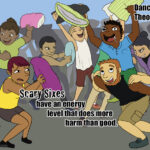Devin ran a real-estate management firm and his team was very close. They celebrated everything from birthdays to anniversaries together. From the outside, you’d assume they were the perfect team, but danger was just under the surface. Devin was actually running a team that was about to rot from the inside out, all because of one team member.
Four years ago, Devin hired Pat through a friendly recommendation. Against his normal hiring protocol to match applicants with company values, he hired Pat quickly without a thorough vetting process. During Pat’s first year, she hit all her metrics, which pleased Devin. On the sidelines, however, a few of his other team members commented on her negative attitude during meetings and team outings. During Pat’s second year, she continued to reach her metrics but comments about her negative attitude continued to be reported. During Pat’s third year, a fellow team member submitted his resignation to Devin. He cited Pat as part of the reason he was leaving.
Another team member brought the topic up to Devin directly. He said that despite everyone else on the team feeling connected and performing at a high level, people couldn’t stand Pat’s negative attitude. He revealed that something needed to be done quickly or else others were planning to resign as well. Devin was torn because Pat consistently performed well. But he didn’t want to lose other members of his team who were not only talented, but also fit the culture of his company. Despite Pat’s high performance ability, she was clearly a Negative Nelly.
In the world of Dance Floor Theory, when an employee constantly has a negative attitude at work that is influencing others, we call them Negative Nellies (NNs). Negative Nellies, like Pat, can be high performers within their own role, but their negative attitude causes damage to the rest of the team. An NN is often someone that doesn’t align with the values of the company. They . Gallup uses the term “Activity Disengaged” to describe NNs in their research. In 2018, Gallup research found that globally, there is almost a 1:1 ratio of engaged to actively disengaged employees within an organization. In short, the problem of NNs is very real and should be dealt with right away. Otherwise, the effects will be devastating to a team.

Three Steps to Dealing with Negative Nellies
1) Confront
Supervisors are notoriously bad at confronting and dealing with difficult people. Paul Gustavson describes this concept in his book A Team of Leaders:* “Dealing with difficult people is something that most supervisors are not usually comfortable with.”
But the first step in mitigating the negative effects of Negative Nellies is to confront them. The goal of a confrontational meeting is gauge how aware the NN is of their behavior, and then to decide on a plan of action.
Here are some keys to confronting someone effectively:
– People vs Problem, not Person vs Person: Make the situation be you and them against the problem, instead of you against them. As Henry Cloud said in his book Integrity *, “Be hard on the issue, soft on the person.”
By focusing on the issue instead of the person, you’re now on the same team, solving the situation together.
– Use a Third Point: Have documentation of the issue and use that data as a third point (like a piece of paper) to reference during a confrontational meeting. Having a third point will amplify the feeling of you and them against the problem. It also allows the negative energy to be directed towards the external object instead of towards each other.
– Actually listen.: So much of conflict happens because neither side is listening to the other. Ask questions and listen to what they are saying. Don’t try and think about what you are going to say next while they are talking; just listen. That way, even if you agree to disagree, both sides can say that they felt heard. Often, people just want to be heard.
“I could save myself a lot of wear and tear with people if I just learned to understand them.”
– Ralph Ellison
2) Fire / Keep
Many business strategy books, like The Energy Bus *, talk about the goal of having the right people on the bus, in the right seat, at the right time. After confronting an NN, you have to make the decision to either keep the person or fire them. If you choose to fire them, do it quickly and move on. As a CEO once told me during a strategy session, “I’ve never regretted firing someone, but many times I’ve regretted keeping someone too long.”
Hiring expert, Geoff Smart, talks about the idea that A players want to work with A Players. B and C players also want to work with A players. But A players don’t want to work with B or C players. A players will often leave a company if the leadership doesn’t fire the B or C players.
In case you are still on the fence about firing an NN, co-Founder of 1-800-Got-Junk, Cameron Herold, says that the cost of keeping bad employees can be has high as 15x their salary. This is due to issues with current employees, company systems, and clients. Jack Welch, former CEO of General Electric, was famous for firing the bottom 10 percent of his employees every year and replacing them with new people. And, in his book Delivering Happiness *, Tony Hsieh, CEO of Zappos, talks about a time when he fired several underperforming employees. By doing so, he found out that the remaining passionate Zappos employees could do just as much work with fewer people. Convinced yet?
“If you have the wrong people, it doesn’t matter the right direction.”
– Jim Collins, Good To Great
3) Fix
Devin did end up confronting Pat on her negative attitude. He decided not to fire her. During the meeting, Devin found out that the amount of travel that Pat was doing for her work was weighing heavily on her. It was causing her to have health issues that were spilling over into everything in her life. Pat actually loved the company, but the particular role she was in was wearing her down. Over the next three months, Devin worked with Pat to change her position to involve less travel. They also checked in with each other regularly to track how her attitude was shifting. In the end, Pat continued to be a high performer. The rest of the team started to enjoy being around her because of her change in attitude.
In summary…
Typically, human behaviors are hard to change. Past actions are a good indicator of future actions. Don’t expect Negative Nellies to change unless there is a new plan to make the change happen. If you choose to keep an NN on your team, create an action plan together on how to turn things around. Then monitor the person’s progress with regular check-ins. If after three months, things are still the same, let the NN go and move on.



